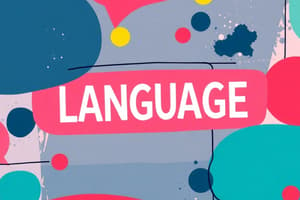Podcast
Questions and Answers
What is the primary function of language?
What is the primary function of language?
- To facilitate the exchange of information between individuals (correct)
- To standardize the meaning of words across cultures
- To differentiate one region from another
- To create a sense of community among non-verbal communicators
What can be inferred about verbal and non-verbal communication?
What can be inferred about verbal and non-verbal communication?
- Verbal communication is more effective than non-verbal communication
- Verbal communication is only used in formal settings
- Non-verbal communication is limited to written messages
- Both verbal and non-verbal communication can convey information (correct)
What is a key characteristic of language?
What is a key characteristic of language?
- It is only used for formal communication
- It is a static system that does not evolve
- It is used universally across all cultures
- It is specific to a particular region or community (correct)
What is communication primarily concerned with?
What is communication primarily concerned with?
What is the role of words in language?
What is the role of words in language?
What is the primary outcome of economic globalization?
What is the primary outcome of economic globalization?
Which of the following is NOT a part of the five-step process of global communication?
Which of the following is NOT a part of the five-step process of global communication?
What is a consequence of language barriers in global communication?
What is a consequence of language barriers in global communication?
What is the primary focus of effective communication in a society?
What is the primary focus of effective communication in a society?
How do people and countries interact and integrate in global communication?
How do people and countries interact and integrate in global communication?
What type of barrier to communication occurs when a term is harmless in one culture but considered a slang in another?
What type of barrier to communication occurs when a term is harmless in one culture but considered a slang in another?
Which type of barrier to communication is caused by faulty equipment and noise?
Which type of barrier to communication is caused by faulty equipment and noise?
What type of barrier to communication occurs when the structure, rules, and regulations of an organization hinder communication?
What type of barrier to communication occurs when the structure, rules, and regulations of an organization hinder communication?
Which type of barrier to communication occurs when a sender or receiver has a physiological issue, such as dyslexia, that interferes with speech or hearing?
Which type of barrier to communication occurs when a sender or receiver has a physiological issue, such as dyslexia, that interferes with speech or hearing?
What type of barrier to communication occurs when the state of the mind of the sender or receiver affects the understanding of information?
What type of barrier to communication occurs when the state of the mind of the sender or receiver affects the understanding of information?
Flashcards are hidden until you start studying
Study Notes
Communication and Language
- Communication is the exchange of information or messages between people, which can occur verbally (through spoken words) or non-verbally (through gestures, facial expressions, etc.).
- Language is a system of communication that enables people to interact with each other and convey messages.
- Language is a regional or community-specific method of communication that uses words to convey meaning.
- Language is used to impart messages between individuals within a particular region or community.
Language and its Nature
- Language is a formal system of words and symbols used for communication
- Communication can occur through speaking, listening, reading, writing, and viewing
Globalization
- Globalization refers to the growing interdependence of the world's economies, cultures, and populations
- It is brought about by cross-border trade, technology, and flows of investment, people, and information
Global Communication
- Global communication refers to the way countries and people of the world interact and integrate
- It involves the exchange of messages across borders
- Economic globalization is the integration of countries into a single global economy, making international trade easier
Communication Process
- The five-step process of global communication:
- A person or organization in one country sends a message
- The message is encoded
- The message travels through a channel or medium
- The receiver in another country decodes the message
- The recipient receives the message
Barriers to Communication
- Barriers to communication can occur due to various reasons
- Types of barriers:
- Semantic barriers (language barriers)
- Psychological barriers (state of mind of sender or receiver)
- Organizational barriers (structure, rules, and regulations)
- Cultural barriers (lack of similarities among cultures)
- Physical barriers (faulty equipment, noise, closed doors, etc.)
- Physiological barriers (physiological issues like dyslexia, nerve disorders, etc.)
Semantic Barriers
- Semantic barriers occur due to language differences
- Examples: use of technical languages, unclear messages
Psychological Barriers
- Psychological barriers occur due to the state of mind of the sender or receiver
- Examples: inadequate information, information passed around many times
Organizational Barriers
- Organizational barriers occur due to the structure, rules, and regulations of an organization
- Examples: complexity of organizational structure, multiple managers leading to misinformation
Cultural Barriers
- Cultural barriers occur due to lack of similarities among cultures
- Examples: differences in beliefs, terms that can be harmless in one culture but regarded as slang in another culture
Physical Barriers
- Physical barriers occur due to factors like faulty equipment, noise, and closed doors
- These barriers can cause distortion of information, leading to miscommunication
Physiological Barriers
- Physiological barriers occur due to physiological issues like dyslexia, nerve disorders, etc.
- These barriers can affect the ability to express or receive messages clearly
Studying That Suits You
Use AI to generate personalized quizzes and flashcards to suit your learning preferences.




